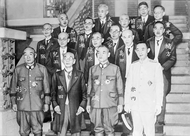Kuniaki Koiso
This article includes a list of general references, but it lacks sufficient corresponding inline citations. (December 2012) |
Kuniaki Koiso | |
|---|---|
| 小磯國昭 | |
Governor General of Korea | |
| In office 15 June 1942 – 22 July 1944 | |
| Monarch | Hirohito |
| Preceded by | Jirō Minami |
| Succeeded by | Nobuyuki Abe |
| Minister of Colonial Affairs | |
| In office 16 January 1940 – 22 July 1940 | |
| Prime Minister | Mitsumasa Yonai |
| Preceded by | Tsuneo Kanemitsu |
| Succeeded by | Yōsuke Matsuoka |
| In office 7 April 1939 – 30 August 1939 | |
| Prime Minister | Kiichirō Hiranuma |
| Preceded by | Yoshiaki Hatta |
| Succeeded by | Tsuneo Kanemitsu |
| Personal details | |
| Born | 22 March 1880 General |
| Commands | |
Kuniaki Koiso (
After Japan's surrender in World War II, he was convicted of war crimes and sentenced to life imprisonment. He died in prison in 1950.
Early life
Koiso was born on March 22, 1880, in Utsunomiya, Tochigi Prefecture, the first son of chief inspector of police and shizoku (former samurai) Koiso Susumu.[1] He attended eight different schools, graduating from Yamagata Middle School (today Yamagata Prefectural Yamagata East High School). He was accepted as an officer candidate in 1898.
Military career
Koiso graduated from the
In November 1910, Koiso graduated from the Army Staff College, 33rd in a class of 55, and returned to the Imperial Japanese Army Academy as an instructor in December 1910.
Reassigned to the
During the 1920s Koiso joined the relatively moderate
In February 1932, Koiso became
Colonial affairs and Korea

Koiso left active duty in July 1938. From April to August 1939, he served in the cabinet of Prime Minister Hiranuma Kiichirō as Minister of Colonial Affairs. He returned to the same post again from January to July 1940 under the Yonai administration.
Koiso was appointed
When news of Korean independence reached him after the war, Koiso scoffed "the dream of Korean independence is as foolish as trying to plot the independence of Kyushu or Hokkaido."[citation needed]
Prime Minister
After the Allied landing in Normandy (June 6) and the successful capture of Saipan (9 July), Hideki Tojo resigned and a new cabinet was formed. In selecting a new Prime Minister, the elder statesmen narrowed the candidates down to three: Hisaichi Terauchi (commander of the Southern Expeditionary Army Group), Shunroku Hata (commander of the China Expeditionary Army), and Koiso.
The Army strongly favored General


Koiso attempted to end army-navy rivalry by creating a Supreme Chief of Staff (最高幕僚長), but this was structured to favor the army, thus bitter opposition from the navy doomed the plan. Instead, a Supreme War Guidance Council (最高戦争指導会議) was created (August 4, 1944 – August 22, 1945). Koiso was not taken seriously at Council meetings, where he was openly contradicted by Hata Hikosaburo. Within the top levels of the Imperial Army, rumors circulated that the Koiso Cabinet would only last two months (it lasted nine months).
Koiso's strategy for ending the war was to strike a hard blow against the American Army in the Philippines, forcing negotiations. However, the general entrusted with the defense of the Philippines, Tomoyuki Yamashita, disagreed with the planners in the Southern Expeditionary Army. As such, the Army and Navy could not agree on a coordinated plan.[5] Nevertheless, the defenders were prepared to make considerable sacrifices when Douglas MacArthur invaded Leyte on October 17, with the first kamikaze attack carried out on October 21, and the Japanese Navy losing four aircraft carriers and three battleships during the Battle of Leyte Gulf. Although the strategy had failed, Koiso did not change his way of thinking. Late in 1944, Koiso still planned to send Prince Fumimaro Konoe on a peace mission to neutral countries, Switzerland and Sweden, but it came to nothing.
During the remainder of Koiso's premiership in office, Japanese forces continued to suffer a string of defeats on all fronts at the hands of the
Later career
Koiso was an ardent supporter of
After the end of World War II, Koiso was arrested by the
Honors
From the corresponding article in the Japanese Wikipedia
- Grand Cordon of the Order of the Rising Sun (April 5, 1934)
- Grand Cordon of the Order of the Sacred Treasure (April 29, 1934)
- Order of the Golden Kite, 2nd class (April 29, 1934)
References
Books
- ISBN 0-14-100146-1.
- Maga, Timothy P. (2001). Judgment at Tokyo: The Japanese War Crimes Trials. University Press of Kentucky. ISBN 0-8131-2177-9.
- Pratt, Keith (2007). Everlasting Flower: A History of Korea. Reaktion Books. ISBN 978-1-86189-335-2.
- ISBN 0-8129-6858-1.
Sources
- OCLC 500498531.
- The Rising Sun: The Decline and Fall of the Japanese Empire, 1936–1945, page 529
- ^ Pratt, Everlasting Flower
- ISBN 4167198037.
- ^ 『昭和天皇独白録』p.117
- ^ Frank, Downfall: The End of the Imperial Japanese Empire
- ^ Maga, Judgement at Tokyo
- ^ "Bedat". Archived from the original on June 29, 2012. Retrieved October 8, 2007.
External links
- Chen, Peter. "Kuniaki Koiso". WW2 Database.
- Bedat, J. "Kuniaki Koiso". Trial Watch. Archived from the original on June 29, 2012. Retrieved October 8, 2007.
- Clancy, Patrick. "HyperWar:IMTFE Judgement". HyperWar Foundation.
